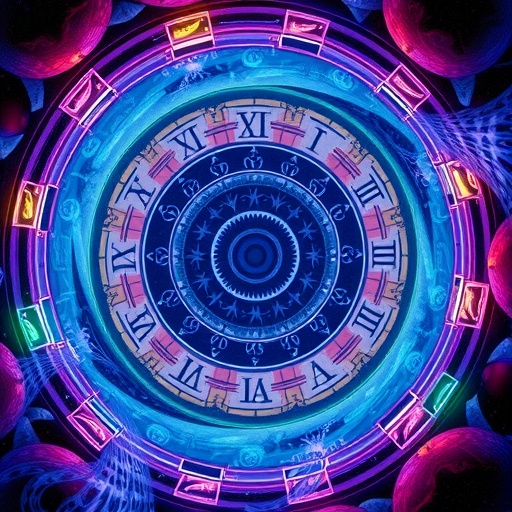In a groundbreaking perspective published today in the journal Psychedelics, Professor Xiaohui Wang and colleagues delve deep into the enigmatic ways psychedelic substances modify human time perception. Their comprehensive synthesis illuminates how classic psychedelics such as psilocybin, LSD, and DMT profoundly distort temporal experience, offering a unique vantage point on the intricate workings of consciousness and unveiling promising therapeutic pathways. This article stands at the crossroads of neuroscience, psychology, and psychiatry, charting new territory in understanding how the brain weaves time into our lived reality.
Human consciousness is intrinsically tied to the perception of time, yet psychedelics distinctly unsettle this fundamental framework. Users often describe paradoxical experiences where seconds stretch seemingly into hours, or conversely, hours flash by in what feels like minutes. Some even report a complete dissolution of the usual boundaries demarcating past, present, and future. These altered states are far from mere curiosity; they provide critical insights into the neural foundations of temporal awareness and selfhood, enabling researchers to probe the scaffolding of subjective time.
Central to these psychedelic-induced temporal disruptions is the modulation of the brain’s default mode network (DMN). The DMN is implicated in self-referential processing and maintaining continuous temporal continuity. Psychedelic compounds suppress activity within this network, an effect strongly correlated with reports of time dissolution and loss of linear, sequential temporal experience. This suppression is particularly salient as dysregulation and hyperactivity of the DMN are hallmark features in psychiatric disorders such as depression and anxiety, suggesting a mechanistic link between time perception and mental health.
Beyond the DMN, psychedelics orchestrate widespread neural network modifications involving the basal ganglia, prefrontal cortex, cerebellum, and insula. The basal ganglia’s role in sub-second interval timing is disrupted, altering millisecond-scale temporal processing. The prefrontal cortex—which integrates longer temporal intervals critical for planning and executive function—exhibits remodeled connectivity in the psychedelic brain. The cerebellum’s traditionally precise timing mechanisms for motor coordination show altered patterns, as does the insula, which contributes to interoceptive awareness and its integration with temporal perception. These multi-regional changes collectively underpin the kaleidoscopic temporal phenomena observed.
At the biochemical level, the serotonin system, especially activation of 5-HT2A receptors, emerges as a primary mediator in these effects. 5-HT2A receptor stimulation enhances cortical excitability and amplifies sensory signal gain, fostering an enriched perceptual landscape wherein time feels expanded. The dopaminergic system is implicated as well, particularly influencing disruptions in shorter interval timing, while glutamatergic NMDA receptor pathways contribute to synaptic plasticity changes that may underlie long-lasting shifts in temporal experience.
The article classifies psychedelic temporal distortions into three principal categories: time dilation, time compression, and timelessness. Time dilation involves the subjective elongation of brief moments, potentially driven by augmented neural oscillatory activity—especially in theta and gamma bands—in regions processing sensory and emotional stimuli. Time compression pertains to moments or hours seemingly collapsing, linked to intense attentional states or experiences of ego dissolution loosening normal temporal anchoring. The most profound alteration, timelessness, entails the experiential merging or irrelevance of past, present, and future, often reported during mystical or peak psychedelic states and tightly associated with DMN downregulation.
Distinct psychedelic substances show differential temporal signatures. Psilocybin notably elicits feelings of timelessness, fostering transcendent states that dissolve temporal boundaries. In contrast, LSD tends to precipitate pronounced time dilation, extending sensory and emotional processing windows. These pharmacological nuances underscore the complex interactions between receptor profiles and neural substrates underpinning time perception.
The therapeutic implications of these findings are both exciting and profound. Disorders such as PTSD, major depressive disorder, and anxiety frequently involve pathological temporal distortions—whether the inescapable reliving of trauma, ruminative negative loops, or anxious anticipation of the future. Psychedelic-assisted therapies appear to reconfigure maladaptive temporal-emotional circuits, enabling patients to cognitively and emotionally reframe traumatic memories from a detached, nonlinear vantage. This temporal decoupling facilitates emotional processing and integration, with patients often attributing symptom relief to these altered experiential frameworks.
Professor Wang and the team propose that psychedelics effect a neural ‘reset,’ disrupting entrenched DMN-mediated patterns and fostering neuroplasticity in regions governing time and emotion. This mechanism may be especially relevant for individuals resistant to conventional treatments, where rigid temporal-emotional schemas underpin clinical symptoms. By rehabilitating temporal perception, psychedelics offer a novel therapeutic angle—one that shifts focus beyond affect and cognition to incorporate temporal recalibration as a core aim.
Despite the promise, the article stresses the necessity for rigorous ethical frameworks and controlled clinical environments to administer these substances safely. The profound transformation of consciousness, including potentially distressing temporal disruptions, demands careful patient preparation, monitoring, and follow-up. Moreover, comprehensive longitudinal studies tracking objective temporal perception alongside neuroimaging biomarkers are vital to unravel causal links and optimize therapeutic protocols.
Challenges remain, not least regulatory constraints that stymie extensive research. Many psychedelics are Schedule I substances under international drug control regimes, limiting legal access and funding. The authors advocate for harmonized, evidence-based regulatory pathways coupled with stringent safety oversight to foster responsible integration of psychedelics into psychiatric care while mitigating misuse risks.
Future investigations must dissect how specific neural oscillatory dynamics, such as theta and gamma synchrony, sustain normal versus altered temporal perception. Determining whether distinct temporal distortion profiles can predict clinical response across psychiatric conditions could enable personalized psychedelic interventions. Furthermore, elucidation of receptor-specific pharmacodynamics promises to refine drug design targeting particular temporal and therapeutic outcomes.
This comprehensive perspective synthesizes the state-of-the-art in psychedelic temporal research with vast implications for consciousness science, neuroscience, and clinical psychiatry. It challenges the prevailing notion of time as an immutable dimension, highlighting its cognitive construction and plasticity under psychedelic influence. For researchers, clinicians, and policymakers, this work provides a roadmap to harness temporal phenomenon insights, offering a catalyst to revolutionize psychiatric treatment paradigms and deepen our fundamental understanding of human experience.
Subject of Research: People
Article Title: consciousness, neuroscience, and therapy
News Publication Date: 21 October 2025
Web References: http://dx.doi.org/10.61373/pp025p.0041
Image Credits: Xiaohui Wang
Keywords: Psychedelics, time perception, consciousness, default mode network, 5-HT2A receptor, temporal distortion, neuroplasticity, therapeutic applications, psilocybin, LSD, DMT, neuroscience




